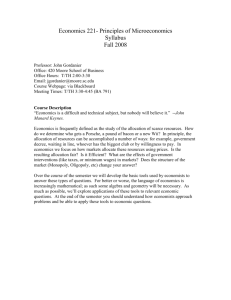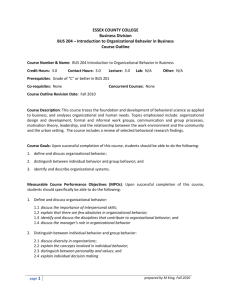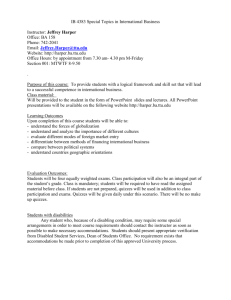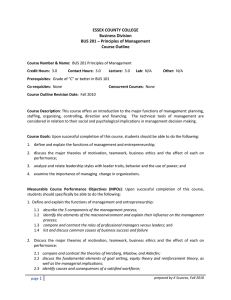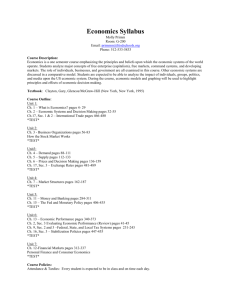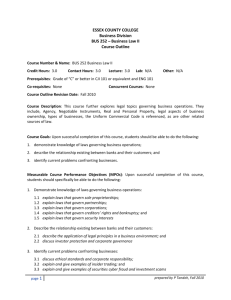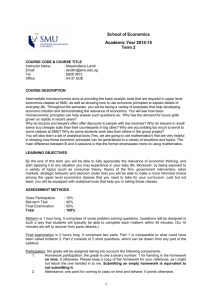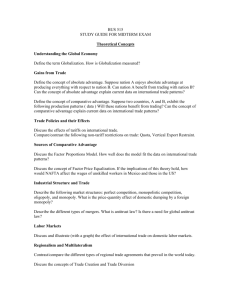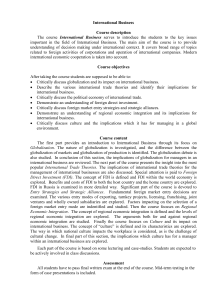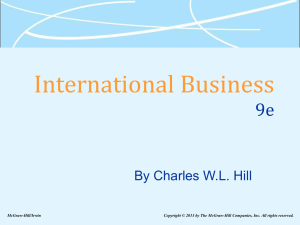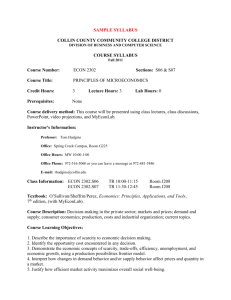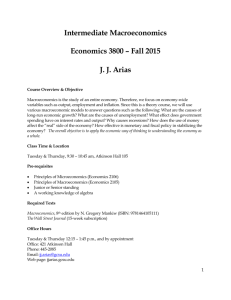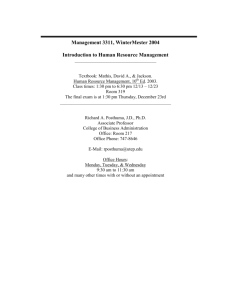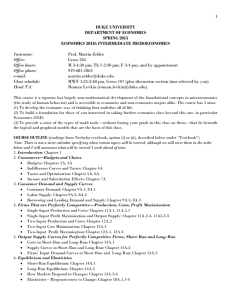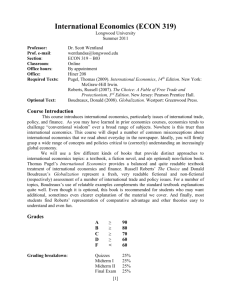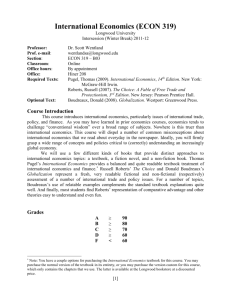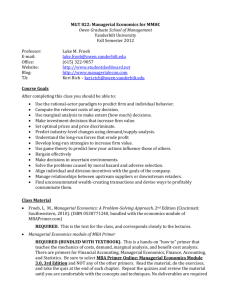Student Learning Outcomes (SLO)
advertisement
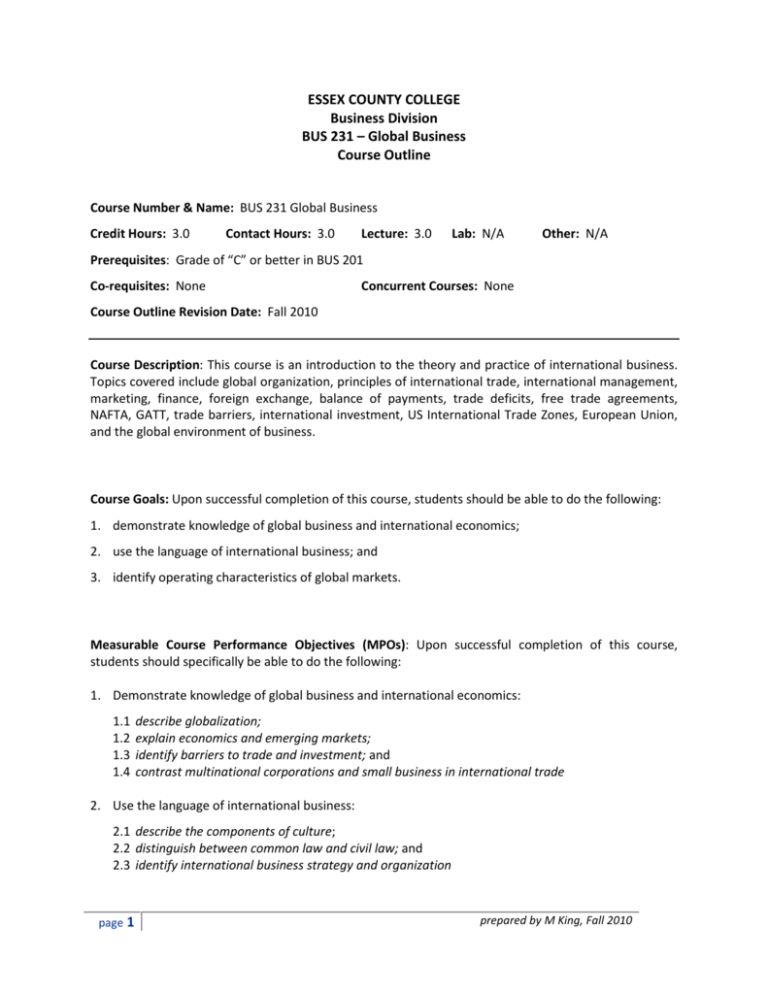
ESSEX COUNTY COLLEGE Business Division BUS 231 – Global Business Course Outline Course Number & Name: BUS 231 Global Business Credit Hours: 3.0 Contact Hours: 3.0 Lecture: 3.0 Lab: N/A Other: N/A Prerequisites: Grade of “C” or better in BUS 201 Co-requisites: None Concurrent Courses: None Course Outline Revision Date: Fall 2010 Course Description: This course is an introduction to the theory and practice of international business. Topics covered include global organization, principles of international trade, international management, marketing, finance, foreign exchange, balance of payments, trade deficits, free trade agreements, NAFTA, GATT, trade barriers, international investment, US International Trade Zones, European Union, and the global environment of business. Course Goals: Upon successful completion of this course, students should be able to do the following: 1. demonstrate knowledge of global business and international economics; 2. use the language of international business; and 3. identify operating characteristics of global markets. Measurable Course Performance Objectives (MPOs): Upon successful completion of this course, students should specifically be able to do the following: 1. Demonstrate knowledge of global business and international economics: 1.1 1.2 1.3 1.4 describe globalization; explain economics and emerging markets; identify barriers to trade and investment; and contrast multinational corporations and small business in international trade 2. Use the language of international business: 2.1 describe the components of culture; 2.2 distinguish between common law and civil law; and 2.3 identify international business strategy and organization page 1 prepared by M King, Fall 2010 Measurable Course Performance Objectives (MPOs) (continued): 3. Identify operating characteristics of global markets: 3.1 explain the importance of the multinational corporation and the role of small business in international trade; 3.2 differentiate the different exporting and importing strategies; and 3.3 describe the development of product and promotional strategies in global business Methods of Instruction: Instruction will consist of lecture, outside reading assignments including the Wall Street Journal and the New York Times, and the viewing of videos related to the field. Outcomes Assessment: Quiz, test, and exam questions are blueprinted to course objectives. Data is collected and analyzed to determine the level of student performance on these assessment instruments in regards to meeting course objectives. The result of this data analysis is used to guide necessary pedagogical and/or curricular revisions. Course Requirements: All students are required to: 1. Maintain regular attendance. 2. Completed assigned homework on time. 3. Take part in class discussions. 4. Take all quizzes, tests, and exams as scheduled. Methods of Evaluation: Final course grades will be computed as follows: Grading Components • Homework, quizzes and class participation 0 – 20% 2 or more Tests (dates specified by the instructor) 25 – 35% Midterm Exam 20 – 25% Final Exam 25 – 30% A perusal of homework and quizzes will provide evidence of the extent to which students are achieving course objectives. • Tests will show evidence of the extent to which students meet course objectives. • The same objectives apply as with tests, but it is anticipated that students will show advanced mastery and synthesis of course content from the first half of the semester. • % of final course grade The comprehensive final exam will examine the extent to which students have mastered the material presented in the course and can analyze and synthesize facts relevant to the course objectives and apply these concepts to given situations. NOTE: The instructor will provide specific weights, which lie in the above-given ranges, for each of the grading components at the beginning of the semester. page 2 prepared by M King, Fall 2010 Academic Integrity: Dishonesty disrupts the search for truth that is inherent in the learning process and so devalues the purpose and the mission of the College. Academic dishonesty includes, but is not limited to, the following: • plagiarism – the failure to acknowledge another writer’s words or ideas or to give proper credit to sources of information; • cheating – knowingly obtaining or giving unauthorized information on any test/exam or any other academic assignment; • interference – any interruption of the academic process that prevents others from the proper engagement in learning or teaching; and • fraud – any act or instance of willful deceit or trickery. Violations of academic integrity will be dealt with by imposing appropriate sanctions. Sanctions for acts of academic dishonesty could include the resubmission of an assignment, failure of the test/exam, failure in the course, probation, suspension from the College, and even expulsion from the College. Student Code of Conduct: All students are expected to conduct themselves as responsible and considerate adults who respect the rights of others. Disruptive behavior will not be tolerated. All students are also expected to attend and be on time for all class meetings. No cell phones or similar electronic devices are permitted in class. Please refer to the Essex County College student handbook, Lifeline, for more specific information about the College’s Code of Conduct and attendance requirements. page 3 prepared by M King, Fall 2010 Course Content Outline: based on the text International Business: The Challenges of Globalization, 5th edition, by Wild, Wild & Hand; published by Prentice Hall, Upper Saddle River, NJ, 2010; ISBN #: 0137153759 Class Meeting (80 minutes) Chapter/Topics 1–2 Chapter 1 Globalization International Business Today Forces Driving Globalization Global Challenges 3–4 Chapter 2 Cross-Cultural Business Culture/Components Social Structure Classifying Culture 5–6 Chapter 3 Politics, Law, and Business Ethics Politics and Culture Political Risks Legal Systems Ethics and Social Responsibility 7–8 Chapter 4 Economics and Emerging Markets Economic Systems Development of Nations Economic Transition 9 Test 1 on Chapters 1 – 4 10 – 11 Chapter 5 International Trade Theories of International Trade Benefits of International Trade 12 – 13 Chapter 6 Business – Government Trade Relations Methods of Promoting Trade Methods of Restricting Trade Global Trading System 14 – 15 Chapter 7 Foreign Direct Investing (FDI) & Chapter 8 Regional Economic Integration Explanations for FDI Government Intervention in FDI Effects of Regional Economic Integration European Union, NAFTA, ASEAN page 4 prepared by M King, Fall 2010 Class Meeting (80 minutes) Chapter/Topics 16 – 17 Chapter 9 International Financial Markets International Capital Market Components of International Capital Market Foreign Exchange 18 Midterm Exam on Chapters 5 – 9 19 – 20 Chapter 10 International Monetary System What Factors Influence Exchange Rates Forecasting Exchange Rates Evolution of the International Monetary System 21 – 22 Chapter 11 International Strategy and Organization Strategy Formulation Identify Mission and Goals Types of Organization Structure 23 – 24 Chapter 12 Analyzing International Opportunities & Chapter 13 Selecting and Managing Entry Mode Screening Potential Markets and Sites Conducting International Research Exporting, Importing, and Countertrade Contractual Entry Modes Investment Entry Modes 25 Test 2 on Chapters 10 – 13 26 – 27 Chapter 14 Developing and Marketing Products Developing Product Strategies Creating Promotional Strategies Distribution Strategies Pricing Strategies 28 – 29 Chapter 15 Managing International Operations & Chapter 16 Managing Employees Production Strategy Acquiring Physical Resources Financing Staffing Policy Labor Management Relations 30 Comprehensive Final Exam page 5 Hiring and prepared by M King, Fall 2010
